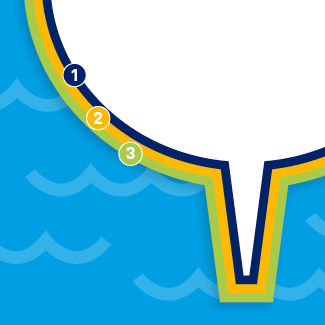How to blast fibreglass hulls without damaging the gel coat
Removing the antifouling paint from a fibreglass hulls is easy with vapour abrasive blasting
Good maintenance is essential to extend the lifetime of your boat or yacht.
The hull in particular needs special care as it is continuously subjected to water, wind, and marine organisms. Frequent re-application of the protective coating guarantees the hull’s water resistance.
As well as the quality of work, efficiency is vital in the maintenance of boats. Removing the antifouling layer is a time-consuming and difficult part of the essential maintenance operations.
The different layers of a boat hull
It is important to understand the different layers of a hull and what their functions are.

1. Gel coat
2. Primer
3. Paint = antifouling
· Gel coat
The gel coat is the first layer on the hull and protects the fibre. It is crucial that the gel coat does not become damaged. For a good adhesion of the primer, the gel coat should have a rugged profile.
· Primer
Under the antifouling paint there is a primer that improves the adhesion of the antifouling layer on the gel coat. It guarantees a strong chemical bond and avoids premature peeling and cracking of the antifouling paint.
· Paint = antifouling
The outer layer of a hull is the antifouling paint. This coating ensures a smooth structure and minimizes the growth of organisms such as algae on the hull. This is important to decrease the water resistance and fuel consumption of the boat.
How to remove antifouling paint
There are a number of stripping methods for removing antifouling paint. Chemical stripping, hand scraping, and wet abrasive blasting are the most commonly used.
· Chemical stripping & hand scraping
A traditional and time-consuming method for vessel stripping includes toxic chemicals, harmful acids, and hand scraping. A caustic chemical product is applied to the hull. After impregnating, the top layer of the hull can be scraped off with a scouring pad or sander. This method can be environmentally damaging and contaminating to local water areas. It also requires long hours of hard work and can be a personal health hazard.
· Wet abrasive blasting
Wet blasting, like traditional dry blasting, relies on an abrasive media delivered at high speed under pressure to remove surface coatings and prepare a surface for finishing. However, wet blasting mixes water into the blast media. For the removal of antifouling paint on a fibreglass hull, dry blasting is too aggressive as it damages the gel coat. Wet blasting is gentle enough to leave the gel coat intact, while still being very effective.
Why choose vapour abrasive blasting for the removal of antifouling?
· Less labour-intensive = faster = cheaper
Wet abrasive blasting is the fastest, most efficient, and most economical way to remove antifouling paint. Using chemical stripping, the removal of antifouling from an average boat takes up to six days. With vapour abrasive blasting, the job is done in less than a day.
· Safe for the environment
Wet abrasive blasting keeps surrounding areas clean and allows others to continue working nearby safely. All non-toxic and silica-free media particles are encapsulated in water and grounded, leaving the surrounded area unaffected. Wet abrasive blasting leaves very little water on the ground since most of the water vaporises and disappears. All that remains is a pile of damped media, making clean-up very easy. A fibre tarp to collect the media and debris would speed up the cleaning process.
· Safe for the gel coat
From antifouling paint, to epoxy, to heavy marine growth, wet abrasive blasting can remove it all without damaging the underlying protective gel coat. That way the hull is immediately ready for a new layer of paint.
